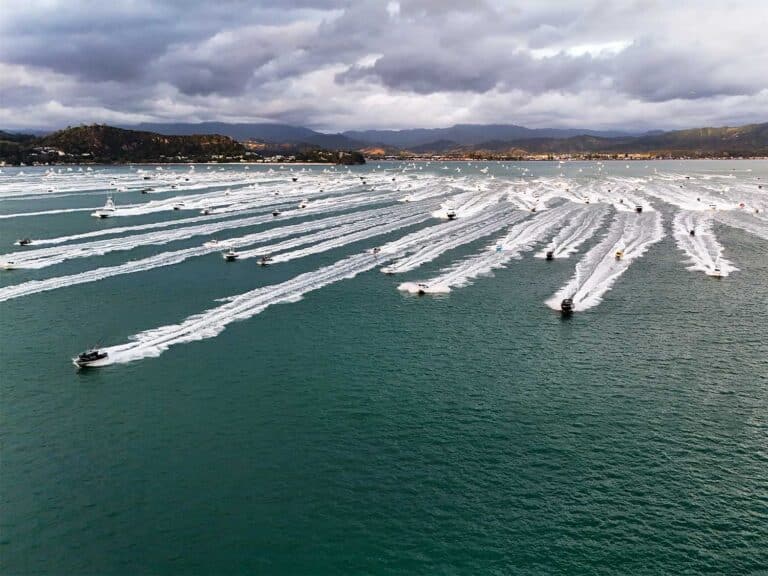
Thinking about changes to your electronics can be daunting. The cost, time and effort involved cannot—and should not—ever be taken lightly. Some refits are forced, brought upon by lightning strikes, equipment failures and age, but generally, upgrades keep you in step with the times, providing the opportunity to correct annoyances or shortcomings of the current technology. The possibility to add the latest high-performance piece of tech to help not only with fishing and navigation, but also to potentially tune up the audio-video systems, is attractive, especially when it keeps everyone sane on a slow day—or a long trip.
Refit or Upgrade
A lightning strike is typically a worst-case scenario that demands you evaluate and replace, and is very different than an upgrade. All equipment necessary for safely operating the vessel should be changed when a strike occurs, and sometimes this includes the associated wiring, power supplies, etc. A professional analysis of the vessel’s post-strike condition is necessary to determine just how extensive the damage is. Some might disagree—after all, we used to navigate by the stars—but a loss of navigational equipment while underway is extremely dangerous, and any compromised equipment should be replaced to be absolutely certain you’re back in the Phoenicians’ good graces. Judgment calls can be made on less-important items such as stateroom televisions because those items obviously are not as necessary as radar, for example.

We should also consider the lifetime of a product. Marine electronics age just like all the other electronic items we use on a daily basis. Similar to devices such as cellphones, computers and televisions, it’s advantageous to stay current. Doing so often keeps the speed of troubleshooting, software updates and repairs manageable. As equipment ages, it often becomes uneconomical to repair, and sometimes difficult to upgrade to the newer versions that are currently operating in the field. And eventually there comes a need to purge items that are aging beyond serviceability (anyone remember Northstar?).

Infrastructure Considerations
What is the existing infrastructure? Weight and strength requirements for mounting, wire distances and power draw should all be reviewed prior to tackling your refit. Doing so can prevent making costly changes midproject, or incompatibilities further down the line, possibly swaying the decision-making process for design and purchase.
Towers and hardtops are initially engineered to support both the weight and form of the equipment at that time. If you wish to change any equipment above the vessel’s roll center, it’s best to compare the weight of the new, planned equipment against the old. If you find a significant difference, then discussing your needs with the tower builder will ensure that your mounting area is sufficient enough to accept the new products. G-forces are multiplied the higher up you go, so this is an area of safety that cannot be ignored.
Helm and control areas are often made of fiberglass, aluminum or acrylic, so consider the size of the new equipment to the form factor of the existing panel, knowing you might require holes to be patched, or perhaps an entirely new panel be manufactured. This is also a good time to consider control location. While a designer might be tasked with fitting 20 switches and controls in a space originally made for 10, having the most important controls ergonomically located while underway will hugely impact your daily boating life.
The cockpit and areas below deck should be studied for access and depth requirements. Oftentimes a visibly “unused” surface will have something living behind it, impeding the simple addition of a new item. Obtaining a CAD drawing of your vessel or consulting with the builder or boatyard can help eliminate time spent attempting to find, and then designate, that perfect spot for your new transducer or LED underwater lights.
Read Next: Meet Roy Merritt in our exclusive interview.
Wiring and Power
The larger the boat, the more important the wiring factor becomes. ABYC and NMEA standards for electrical and electronics requirements should always be adhered to, and manufacturers’ proprietary cabling needs to be considered as well. DC-power wiring is determined by amperage, voltage and distance. Wiring for high-current items such as amplifiers and large lights typically demands a lower-gauge wire, and the longer the run, the larger in size the wire must be. A high-current draw set of spreader light wires can mean less space in the hardtop and/or tower leg. And RF (radio frequency) cabling for satellite TV or a VHF radio should be specified based on run length versus loss. Proprietary cabling sometimes provides only a few feet of distance between items, and not addressing the wire equation properly can lead to several issues if not studied in advance. For example, some sonars have a manufacturer-stated set length of wiring between the transducer and transceiver of 15 feet. This can present quite the challenge with modern-day engine rooms that are often begging for more real estate.
The existing batteries, chargers and power feeds (and their capacities) need to be reviewed because the equipment’s power must cover the equipment’s draw. If this is disregarded, a slew of issues will most likely arise. Any changes affecting power should be evaluated by a certified marine electrician to determine if any improvements are necessary to support the planned electronics. What’s the point of having new equipment if the power infrastructure can’t accommodate it?
In short, whenever considering an electronics refit—forced, warranted or simply coveted—it’s necessary to get real answers to the real questions first. What replacements are needed, and can your boat handle it? From there it’s up to you to finalize your choices based on what your needs are and what your boat can support, ultimately committing to make the changes to refit successfully. And sometimes, although we might not want to hear it, our expectations just don’t jive with reality, unless you’re willing to go the extra mile. Always do what you absolutely need first; everything after that—such as a new, high-definition marine satellite-TV system—is gravy.







